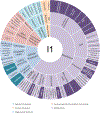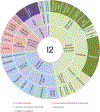Differential gene expression reveals host factors for viral shedding variation in mallards (Anas platyrhynchos) infected with low-pathogenic avian influenza virus
- PMID: 35353676
- PMCID: PMC10519146
- DOI: 10.1099/jgv.0.001724
Differential gene expression reveals host factors for viral shedding variation in mallards (Anas platyrhynchos) infected with low-pathogenic avian influenza virus
Abstract
Intraspecific variation in pathogen shedding impacts disease transmission dynamics; therefore, understanding the host factors associated with individual variation in pathogen shedding is key to controlling and preventing outbreaks. In this study, ileum and bursa of Fabricius tissues of wild-bred mallards (Anas platyrhynchos) infected with low-pathogenic avian influenza (LPAIV) were evaluated at various post-infection time points to determine genetic host factors associated with intraspecific variation in viral shedding. By analysing transcriptome sequencing data (RNA-seq), we found that LPAIV-infected wild-bred mallards do not exhibit differential gene expression compared to uninfected birds, but that gene expression was associated with cloacal viral shedding quantity early in the infection. In both tissues, immune gene expression was higher in high/moderate shedding birds compared to low shedding birds, and significant positive relationships with viral shedding were observed. In the ileum, expression for host genes involved in viral cell entry was lower in low shedders compared to moderate shedders at 1 day post-infection (DPI), and expression for host genes promoting viral replication was higher in high shedders compared to low shedders at 2 DPI. Our findings indicate that viral shedding is a key factor for gene expression differences in LPAIV-infected wild-bred mallards, and the genes identified in this study could be important for understanding the molecular mechanisms driving intraspecific variation in pathogen shedding.
Keywords: influenza; shedding; transcriptomics; virus.
Figures










Similar articles
-
Host gene expression is associated with viral shedding magnitude in blue-winged teals (Spatula discors) infected with low-path avian influenza virus.Comp Immunol Microbiol Infect Dis. 2022 Nov-Dec;90-91:101909. doi: 10.1016/j.cimid.2022.101909. Epub 2022 Nov 7. Comp Immunol Microbiol Infect Dis. 2022. PMID: 36410069 Free PMC article.
-
The association between SAα2,3Gal occurrence frequency and avian influenza viral load in mallards (Anas platyrhynchos) and blue-winged teals (Spatula discors).BMC Vet Res. 2020 Nov 10;16(1):430. doi: 10.1186/s12917-020-02642-7. BMC Vet Res. 2020. PMID: 33167978 Free PMC article.
-
Influence of body condition on influenza A virus infection in mallard ducks: experimental infection data.PLoS One. 2011;6(8):e22633. doi: 10.1371/journal.pone.0022633. Epub 2011 Aug 16. PLoS One. 2011. PMID: 21857940 Free PMC article.
-
Effect of different routes of inoculation on infectivity and viral shedding of LPAI viruses in mallards.Avian Dis. 2012 Dec;56(4 Suppl):981-5. doi: 10.1637/10151-040812-ResNote.1. Avian Dis. 2012. PMID: 23402123
-
Genomic characterization of H14 subtype Influenza A viruses in new world waterfowl and experimental infectivity in mallards (Anas platyrhynchos).PLoS One. 2014 May 1;9(5):e95620. doi: 10.1371/journal.pone.0095620. eCollection 2014. PLoS One. 2014. PMID: 24788792 Free PMC article.
Cited by
-
Molecular cloning and characterization of duck CD83 and its effect on H9N2 avian influenza viruses replication.Poult Sci. 2025 Jul 13;104(10):105570. doi: 10.1016/j.psj.2025.105570. Online ahead of print. Poult Sci. 2025. PMID: 40729815 Free PMC article.
-
Prolonged viral shedding prediction on non-hospitalized, uncomplicated SARS-CoV-2 patients using their transcriptome data.Comput Methods Programs Biomed Update. 2022;2:100070. doi: 10.1016/j.cmpbup.2022.100070. Epub 2022 Sep 6. Comput Methods Programs Biomed Update. 2022. PMID: 36090806 Free PMC article.
-
Host gene expression is associated with viral shedding magnitude in blue-winged teals (Spatula discors) infected with low-path avian influenza virus.Comp Immunol Microbiol Infect Dis. 2022 Nov-Dec;90-91:101909. doi: 10.1016/j.cimid.2022.101909. Epub 2022 Nov 7. Comp Immunol Microbiol Infect Dis. 2022. PMID: 36410069 Free PMC article.
References
-
- Vanderwaal KL, Ezenwa VO. Heterogeneity in pathogen transmission: mechanisms and methodology. Funct Ecol. 2016;30:1606–22.
Publication types
MeSH terms
Grants and funding
LinkOut - more resources
Full Text Sources
Medical

